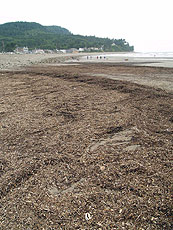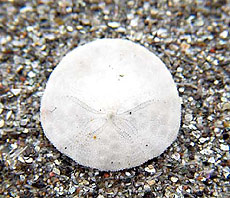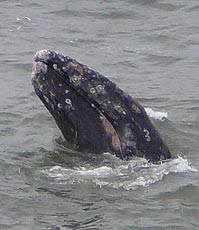 |
The Ocean Burps on Oregon Coast, Other Surprises Arrive
Published Aug 2007
All photos by Tiffany Boothe, Seaside Aquarium (unless otherwise noted)
 |
| Hermit crab shell |
(Seaside, Oregon) – A host of interesting natural events are happening on the Oregon coast, especially the northern coast, bringing strange objects onto the beaches, brown waves, and an unusual phenomenon known as “glowing sand” to the shoreline and the bays. Many of these things are tied together – and they could be tied to the dead zone now appearing again on the central coast. All these fun and fascinating occurrences may not end here, as some more natural wonders are expected because of these conditions.
It means a very exciting August for tourists to the Oregon coast – and Mother Nature is putting on a rather unique display.
 |
| Ocean burp - technically known as detritus |
It all started with the big dead zone off the central Oregon coast, where so much phytoplankton gets pushed into the upper layers of the ocean by deep water upwellings of colder water, that the sheer numbers of these tiny creatures and their decaying bodies choke off the oxygen in the water. This is the sixth year in a row it has made its appearance, and the reason for it seems to be global warming.
Those kinds of upwellings have other interesting effects as well.
This weekend, an extremely large “ocean burp” occurred in Seaside, bringing up a wealth of intriguing things to the cove area at the extreme southern end of town. Its technical name is detritus, meaning a bundle of stuff from the ocean deep gets coughed up by large upwellings of cold water from that region, and these are then deposited on the shore by the waves. These tend to happen more in the winter time, when a combo of upwellings and winter storms throws a lot of stuff on the beaches with regularity.
 |
| Tiny fish bone found by Boothe |
This ocean burp was about 20 feet in diameter worth of stuff scattered around, said Tiffany Boothe, of the Seaside Aquarium. It was six inches deep in some places, although not as dense in others.
“It was a good size burp that washed up in the cove area,” Boothe said. “The burp consisted of bark chips, small pieces of kelp and seaweed, colorful algae, hermit crabs, shells, tube worm casings, skate egg casings, small fish bones, a variety of sponges and crab shells."
The mass of debris is expected to wash away anytime, but in the meantime Boothe is filled with glee over the finds she managed to photograph with extraordinary expertise.
 |
| Ocean burp covers a large area at the cove in Seaside |
"I found three whole sand dollars smaller than a penny," she said.
This occurrence was half expected by aquarium staff, she said, as the temperature had been doing some interesting things. It’s been notoriously warm for a few weeks, often in the 60’s. Then a sudden drop signaled something else was going on, which then heralded several other things that may – and have - happened.
“We weren’t completely surprised to see this,” Boothe said. “We were seeing high temperatures in the ocean of 66 or even 68. Then it dropped down to around 56, 57. The north winds started cooling things off, the upwellings started happening, so we expected to see something. I think it’s possible we’ll start seeing a lot of pelicans around, because the upwellings bring all the nutrients, which then bring the baitfish. The pelicans go for those.”
Baitfish are smaller fish like anchovies, herring and schade.
 |
| Whale burp in the cove |
“We’re also hoping the cove will get a lot of porpoises again, like they did last year at this time,” Boothe said.
These ocean upwellings are also bringing up a lot of phytoplankton, which last year meant many sightings of the famed and mind-blowing “glowing sand” effect. This is created by a species of phytoplankton called dinoflagelettes, which give off a faint greenish blue glow when stopped on or disturbed in the water.
Several residents of the Nehalem Bay said the little critters were quite lively about a week or two ago, but are somewhat tapering off now.
 |
| Sea Sponges found on the beach |
They are seen by scuffing your feet along the sand on a very dark beach at night. Where they are on each beach is different from one to the next. But if you find them in standing water, the results can be especially spectacular. They will explode like tiny galaxies beneath your feet.
If you run your hand through bay waters like in Nehalem Bay or Tillamook Bay, you’ll see these odd, glowing trails behind your hand. You’ll have to find a very dark area, and one where you won’t fall in as well.
BeachConnection.net staff spotted them in Cannon Beach late Sunday night, but they were faint.
 |
| Tiny sand dollar, smaller than a penny |
Dinoflagelettes do this because they are bioluminescent – meaning they give off energy by glowing, in much the same manner as fireflies.
Boothe also reported seeing some brown waves around Seaside, although observers on the central coast are not seeing that. This also means an exceptional abundance of phytoplankton called diatoms.
It’s possible all this has something to do with whatever is causing such an enormous upwelling on the central coast that the dead zone has begun again. It could be the harbinger of a lot of nutrients and phytoplankton, bringing in the brown wave-making diatoms and the glowing dinoflagelettes. Boothe certainly believes so.
 |
| Pelicans gather at the cove in Seaside in a previous year |
“Last year, when the dead zone started, we started seeing a lot of nutrients in the ocean,” she said. “I’ll bet we’ll start to see a pattern here every year.”
Down in Depoe Bay, these kinds of upwellings have in the past meant tons of whales floating around that area, feeding on the abundance of phytoplankton. Like the winter of 2005, when whales were insanely plentiful.
But so far, those manning the stations at the Whale Watch Center in Depoe Bay aren’t noticing anything – yet. Linda Taylor, an interpreter with the Whale Watch Center, said nothing remarkable has happened with their tallies on whale sightings.
 |
Whale doing a spyhop in Depoe Bay (photo by Morris Grover, Whale Watch Center) |
“We haven’t seen a ton here,” Taylor said. “But they are out there. They’re being seen around Devil’s Punchbowl, Cape Foulweather, and even down in Seal Rock – and north of here. There’s nothing unusual about the numbers of them for this time of year, though.”
Taylor said this time of year seems to be different every other year when it comes to whale numbers. “I know there were a lot seen last year at this time, but not many the year before. But the year before that, there were quite a few. Aside from that, we have no data because we weren’t around before that.”
Taylor said the waters off the central coast are showing a drop in temperature as well. A buoy 20 miles offshore from Newport recorded 52 degrees in the ocean, although the temperatures will be lower that far out than close to shore.
 |
| Brown waves in Seaside this past spring: it's not as intense a color now |
Last year, the dead zone seemed to be the cause of enormous amounts of crabs in Yaquina Bay and other places as far north as Tillamook, reaching record numbers of catches and hauls by tourists and residents were crabbing for personal use. It’s believed that dead zone pushed the population to other places, like Newport’s bay.
Fishermen reported plenty of other places where no crabs were found as well.
In the meantime, Boothe has been kicking back and enjoying the oddities that the ocean has been displaying, and looking forward to more.
“I just went down to the cove the other day to get away, sip some coffee, and see if maybe the porpoises were back,” she said. “Instead I found the ocean burp there.
“Conditions are ripe for something else interesting to happen. But I’m going on vacation. I have this feeling all the cool stuff will happen when I’m gone.”
More About Oregon Coast hotels, lodging.....
More About Oregon Coast Restaurants, Dining.....
 |
 |
LATEST OREGON COAST NEWS STORIES
Oregon Coast, Valley and Likely Washington Coast to Get Some Aurora Borealis ... |
Back to Oregon Coast
Contact Advertise on BeachConnection.net
All Content, unless otherwise attributed, copyright BeachConnection.net Unauthorized use or publication is not permitted
Secrets of the Season |
Unusual Travel Articles TravelParanormal.com allows you to submit your own creepy tale or debunk one - or see up-to-the-minute news headlines about travel and the paranormal. News Headlines from All Over Oregon Need to scan Oregon headlines? Constantly updated news from all over Oregon: a comprehensive, up-to-the-minute display of news headlines from a variety of media |





































